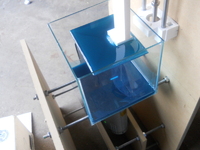 We’ve observed a few developments in resin-based 3D printing recently. While most personal 3D printers today use the fused deposition modeling approach (melted plastic squirted in a precise path, layer by layer), the resin approach is very different and in many ways offers advantages.
We’ve observed a few developments in resin-based 3D printing recently. While most personal 3D printers today use the fused deposition modeling approach (melted plastic squirted in a precise path, layer by layer), the resin approach is very different and in many ways offers advantages. The resin approach involves light-curable liquid resin. Simply illuminate the “pixels” requiring solidity and you’ve instantly made a single layer. Drop the platform a bit and a fresh wash of resin is quickly ready for “flashing” the next layer. No waste, high resolution and quick prints. This approach is used by large commercial 3D printers, but has been quite expensive due to machine costs and proprietary resin chemistry.
On Thingiverse we see maker ScribbleJ has posted the beginnings of a theoretical USD$200 resin 3D printer. The core of this printer is a used DLP projector, capable of illuminating individual pixels with just the right frequency of light to cure the resin.
But what about the expensive resin required by this approach? ScribbleJ has selected Bucktown Polymers as a source for resins. Bucktown seems to be focused on providing ultra-low cost photo-curable resin, specifically for use in resin-based 3D printers. How cheap is it? Apparently the price by volume of these resins is sometimes less than the cost of common PLA filament.
ScribbleJ’s design is not the only inexpensive resin 3D printer in the works; Check out the Lemoncurry Open Source UV Photopolymer DLP 3D Printer or Junior Veloso’s project. It appears we have the beginnings of a small ecosystem for this type of 3D printer.


I love these types of printers… The resolution, the speed… Cool stuff. But their main drawback is that prints must be kept away from sunlight otherwise the same UV light will render the piece brittle and cracked. Not a very good candidate for household use or DIY projects.
I love these types of printers… The resolution, the speed… Cool stuff. But their main drawback is that prints must be kept away from sunlight otherwise the same UV light will render the piece brittle and cracked. Not a very good candidate for household use or DIY projects.